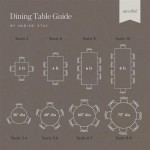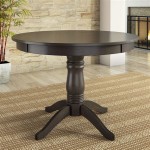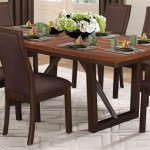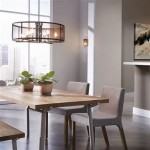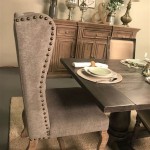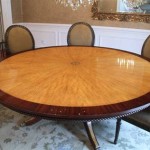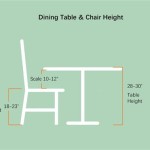Round to Oval Dining Room Tables: A Guide to Making the Right Choice
Dining room tables are the centerpiece of any dining area, serving as a gathering place for meals, conversation, and celebrations. The shape of the table plays a crucial role in setting the tone and functionality of the space. While round tables exude a sense of intimacy and conversation, oval tables offer a blend of elegance and practicality. Understanding the pros and cons of each shape can help you choose the ideal table for your dining room.
Benefits of Round Dining Tables
Round dining tables are known for their inviting and communal nature. Their lack of sharp corners creates a sense of unity and promotes conversation among all guests. Here are some key benefits of round tables:
- Promotes Conversation: The circular shape encourages eye contact and conversation flow, making it ideal for gatherings and intimate dinners.
- Space Efficiency: Round tables tend to be more space-efficient than square or rectangular tables with the same seating capacity. This is particularly beneficial for smaller dining areas.
- Easy Access: Everyone at a round table has equal access to the center, eliminating the need for people to reach over others.
- Visual Appeal: The soft, rounded edges of a round table add a touch of elegance and sophistication to any dining room.
Benefits of Oval Dining Tables
Oval dining tables combine the intimacy of a round table with the functionality of a rectangular table. Their elongated shape offers a balance of openness and coziness, making them suitable for various dining occasions.
- Spacious Seating: Oval tables offer more seating capacity than round tables with the same diameter, accommodating larger gatherings comfortably.
- Comfortable Seating: The curved sides of an oval table provide ample legroom and create a sense of spaciousness for diners.
- Versatility: Oval tables can be placed against a wall or in the center of the room, making them adaptable to different dining room layouts.
- Elegant Appeal: The graceful, elongated shape of an oval table exudes a sense of refinement and sophistication.
Factors to Consider When Choosing Between Round and Oval Tables
The decision between a round and oval dining table depends on a variety of factors, including dining room size, seating capacity, personal preferences, and intended use. Here are some key considerations:
- Dining Room Size: Round tables are suitable for smaller dining rooms, while oval tables offer more seating and are better suited for larger spaces.
- Seating Capacity: Round tables typically accommodate 4-8 people, while oval tables can comfortably seat 6-10 people.
- Dining Styles: If you frequently host large gatherings, an oval table is a better choice. For intimate dinners, a round table can create a more intimate atmosphere.
- Aesthetics: Round tables are often associated with a classic and timeless aesthetic, while oval tables can offer a more modern or transitional look.
By carefully considering these factors, you can select the dining table that best meets your needs and enhances the ambiance of your dining room.

Novac Round Extendable Dining Table 1 2m

Novac Round Extendable Dining Table 1 2m

Denise Oval Dining Table As Is

Manor Extension Dining Table Round To Oval Furniture On Main

Oval Dining Tables Kitchen Pottery Barn

Round Dining Table And Oval Tables In Oak Earthy Timber

Oval Dining Tables Kitchen Pottery Barn

Extendable Japandi 6 Seater Dining Table Whitewash Oval Round Homary
Oak And Walnut Solid Wood Dining Tables Iconbydesign

78 74 Modern Marble Round Classic Minimalist White Oval Dining Table Set For 6 8 Glossy Sintered Stone Tabletop Roman Column Frame Legs

